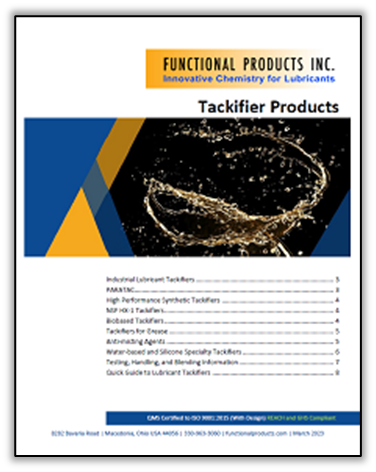
(click to open the brochure)
Tackifiers are additives that confer a tack, or stringiness, to a substance and are typically used to provide adherence in fluid lubricants and stringiness in grease.
Thickeners give additional body to greases and fluid lubricants. Both tackifiers and thickeners also provide drop resistance and serve to inhibit stray mist in pneumatic system lubricants.
Functional Products offers a wide range of tackifiers to fit your requirements. Custom products are our specialty. If your needs require a formulation which is not available in our standard line, we will be happy to create a custom tackifier to meet your needs.
Additional Information
Frequently Asked Questions about Tackifiers
1. What is a tackifier in lubricants and greases?
A tackifier is a polymer additive that increases adhesion and film strength, helping lubricants and greases cling to metal surfaces and resist sling-off, drip, and wash-out.
2. How do tackifiers improve performance in lubricating oils?
They create elastic, cohesive oil films that stay in place under shear, improving protection, cleanliness, and lubrication life in gears, chains, and cables.
3. What types of tackifiers does Functional Products Inc. offer?
Functional Products supplies OCP-, PIB-, and ester-based tackifiers for lubricants, greases, and metalworking fluids including options for petroleum, biobased / biodegradable, water-based, esters, and silicone systems.
4. What is the difference between OCP and PIB tackifiers?
OCP tackifiers provide balanced shear stability and viscosity control; PIB tackifiers deliver stronger elasticity and water resistance—ideal for chain oils and open gears.
5. Can tackifiers improve grease adhesion and water resistance?
Yes. FUNCTIONAL brand tackifiers enhance grease adhesion, reduce water wash-out, and increase mechanical stability in lithium, calcium sulfonate, and aluminum complex greases.
6. What are the benefits of tackifiers in metalworking fluids?
They improve film persistence and lubricity on cutting tools and workpieces, minimizing smoke, chatter, and wear while enhancing surface finish.
7. Are FUNCTIONAL tackifiers compatible with synthetic base oils?
Yes—designed for PAO, PAG, esters, and Group III base oils to ensure clarity and solubility in high-performance synthetic lubricants. Our technical staff will guide you to the best option based on our experience and your technical objectives.
8. What applications benefit most from tackifiers?
Typical uses include chain lubricants, bar-and-chain oils, wire rope oils, open-gear greases, way lubes, and marine EALs where film retention is critical.
9. Are Functional tackifiers available in biodegradable or EAL grades?
Yes. The V-500 Series tackifiers meet OECD 301 biodegradability standards for Environmentally Acceptable Lubricants (EALs) in marine and forestry equipment.
10. What is the normal treat rate for tackifiers in lubricants and greases?
Treat rates range from 0.1–3 % in lubricants and 1–5 % in greases, depending on base oil viscosity and desired stringiness.
11. How are tackifiers measured for effectiveness?
Key tests include the ductless siphon test for lubricants and the Falex TAA tack tester for greases and semi-fluid coatings. Anti-mist performance can further be evaluated through our in-house spray methods.
12. Can tackifiers thicken lubricants or change viscosity?
Slightly—especially V-180 Series OCP-based grades —but most Functional grades are formulated for minimal viscosity impact.
13. How do tackifiers reduce sling-off in chain and gear applications?
By increasing film cohesion and surface adhesion, tackifiers prevent oil from being flung off high-speed chains or gears, cutting consumption and mess.
14. Can tackifiers be used with EP or anti-wear additives?
Yes. FUNCTIONAL tackifiers are chemically inert and compatible with ZDDP, sulfur-phosphorus EP, and moly systems.
15. Do tackifiers affect demulsibility or air release?
At proper treat rates they maintain good demulsibility, air release, and foam control; over-treating can reduce performance.
16. Are tackifiers useful in biodegradable ester base oils?
Yes. FUNCTIONAL V-500 Series tackifiers maintain strong adhesion and film stability in ester and vegetable-oil systems.
17. What makes a good tackifier for high-temperature lubricants?
Thermally stable polymers like OCP and ester-based tackifiers resist oxidation and maintain film integrity up to 200 °C.
18. Are tackifiers shear-stable in high-shear systems?
Functional tackifiers are engineered for high mechanical stability, maintaining adhesion and viscosity in hydraulic pumps and transmissions.
19. Can tackifiers reduce friction and wear?
Indirectly—by ensuring continuous film coverage, they prevent boundary contact, reducing wear and extending equipment life.
20. How do tackifiers improve chain-saw bar and chain oil performance?
They prevent oil fling, improve bar lubrication, and reduce wear on chain links and rails—essential for forestry and outdoor power equipment.
21. Are tackifiers compatible with calcium sulfonate complex greases?
Yes—they improve adhesion, saltwater resistance, and corrosion protection without destabilizing the sulfonate structure.
22. Can tackifiers be used in way oils or slideway lubricants?
Absolutely—they reduce stick-slip, enhance smooth machine motion, and maintain consistent film strength on metal slides.
23. Are tackifiers used in rust-preventive coatings or wax emulsions?
Yes—they improve adhesion and flexibility, forming more durable rust-preventive and protective films.
24. Do tackifiers work in water-based or semi-synthetic metalworking fluids?
Yes—Functional Products offers emulsifiable and water-compatible tackifiers for soluble-oil and semi-synthetic formulations.
25. How can I select the right tackifier for my lubricant or grease?
Contact Functional Products Inc. for formulation support—our team will match the right polymer chemistry, viscosity, and polarity for your lubricant, grease, or metalworking fluid. Contact us today!


